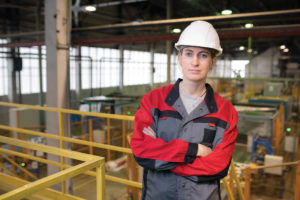What Kind of Safety Gates Do You Need?
By: Maureen Paraventi
Guard rails and other types of physical barriers are vital to worker protection in certain environments. They make sure that people don’t come into contact with vehicles or hazardous machinery and equipment. However, when it’s necessary for personnel to have some type of access to areas that are enclosed or divided by protective guarding, it’s not enough to simply leave a gap between guard rail sections. That leaves room for human error which is an all-too-common occurrence in noisy, busy environments that are full of distractions. Industrial safety gates are a solution that allows both access and protection.
Does OSHA require safety gates?
OSHA does not specifically mandate the use of safety gates. However, they are one way of complying with OSHA 1910.29 (b), which addresses fall hazards:
“The employer must ensure guardrail systems meet the following requirements: (13)(i) Has a self-closing gate that slides or swings away from the hole, and is equipped with a top rail and mid-rail, or equivalent intermediate member, that meets the requirements in paragraph (b) of this section; or (13)(ii) is offset to prevent an employee from walking or falling into the hole.”
What to consider
Every factory, warehouse or distribution center or other type of facility has unique needs when it comes to safety gates, based on:
- The layout or floor plan of the facility
- Existing or planned guardrails or barriers (safety gates must be able to withstand the same amount of force and be at the same heights as existing rails)
- Areas that need to be accessed by employees, visitors or contractors
- Specific hazard areas
In order to determine the right types, sizes and materials of the safety gates needed at your facility, it’s necessary to take all of the above into consideration. Gates may be self-closing, made for specific areas – like loading docks and mezzanine – or customized to a facility’s unique needs. Depending upon the manufacturer, they are available in materials that include aluminum, stainless steel and carbon steel and finishes such as galvanized and safety yellow powder-coat.
Questions to ask before selecting a safety gate:
- What is the size of the opening?
- Where will the safety gate be installed? (Pallet drop areas? Loading docks?)
- Do I need stainless steel for a special application or environment that requires rust or corrosion resistance?
- Do I need a gate that offers a custom length or mount?
- Will the gate need to mount from a left or right position?
Types of industrial safety gates include:
Self-closing gate. A spring in this kind of gate causes it to automatically close after each use. Self-closing gates can serve as passive fall protection systems and are ideal for platforms, stairs and ladder ways.
Loading dock gate. The basic loading dock gate is easy-to-open gate and generally doesn’t take up much space. It protects against falls from loading docks. Other styles for docks including a vertical lift loading dock gate and a cantilever dock door gate.
Mezzanine safety gates. These keep your workers safe during the pallet loading and unloading process.
Clear-aisle safety gates. Some models can take up less than a foot of aisle space when open to the mezzanine floor, making them ideal for tight spaces.
Clear-height safety gates are a good fit for spaces with overhead movers or tight clearances.
Pivot-style safety gates protect open areas of pallet rack systems, elevated platforms, mezzanines and elevated platforms during loading and unloading.
Safety gate materials and finishes
Determining which material the safety gates in your facility should be made of and the finishes they should have starts with a careful assessment of the environment in which they’ll be installed. If the gates will need to be washed regularly, stainless steel might be the best choice. For many warehouses and material handling operations, painted mild steel will be an economical option and, when treated with powder coating, will have a crack-resistant finish. Some safety gate types are also available in carbon steel and aluminum versions.
Choosing bold, safety-related colors – like bright yellow – can help amp up the protective level of gates, especially if the colors are a contrast to those of the stationary guard rails to which the gates are connected. Contrasting colors may also be used to designate an area with special hazards. If there is a dominant color scheme throughout the facility, having safety gates of a different color will make sure they’re immediately identifiable, even from a distance.
Installing industrial safety gates is a relatively easy way to keep personnel in certain parts of your facility safe – especially from falls – without affecting operations. WMHS




